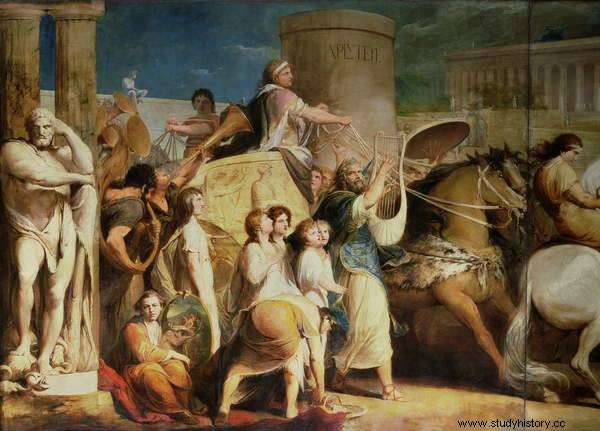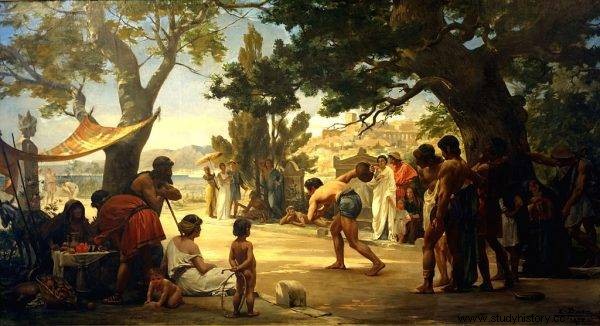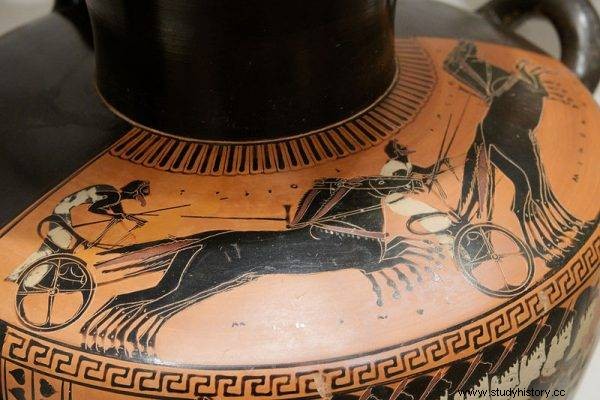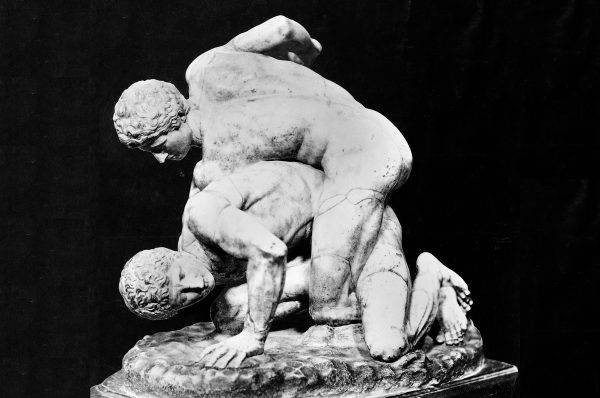One could hit with fists, legs, head, elbows - on any part of the body. It was possible to strangle an opponent, break his limbs and fingers. All for the sake of Zeus.
This is how Greek players fought in a discipline called pankration, which was part of the Olympic struggle . For any deviation from the rules, the judges punished the players with blows of long rods. They only allowed for biting and gouging out the eyes ...
In honor of Zeus
The ancient Greeks gave the world a lot. A timeless mythology containing archetypes of the human condition and psyche. Theatrical art, rhetoric, philosophy, basics of mathematics. Models of civic attitude and democratic system. It all sounds majestic. However, it must be remembered that Greece from thousands of years ago was made of flesh and blood people - not philosophers .

What was the ordinary life of the Hellenes like? What were their cities and rituals like? The curious will know the answers to this question on April 10. Polsat Viasat History will broadcast the first in a series of documentary films "Expedition for treasures with Bettany Hughes" , devoted to monuments and people's lives in Ancient Greece. The researcher will manage, among others to Olympia, one of the most magnificent religious complexes in Hellas. It was here blood sacrifices were made to Zeus . Here, too, Greek athletes competed in competitions to honor the gods.
The first Olympic Games in history
Today it is impossible to clearly define where the Olympic tradition among the Greeks came from. Sources lead to myths. According to one version, the competition was to be created by Zeus himself after a victorious fist fight with Kronos over the world. According to another, the games were established by the favorite of the gods, Pelops . He was, trying to win the hand of King Oydomeos' daughter Hippodamei, was to take part in the chariot race . Those who lost ended miserably - harpooned. Pelops turned out to be clever. He bribed the servant king, and the king damaged the axle in Oydomeos' carriage. As Pelops sped his chariot, the king's vehicle shattered and the king was killed. However, the agreement was kept. Pelops married Hippodamea. For his crime, to appease the deities, he was to call up the Olympic Games.
The first historic Olympics were held in 776 BCE. From then on, they were held regularly every four years until the 4th century CE. The competition always started at the turn of July and August, during the full moon. Peace was proclaimed throughout the Hellenic world for the duration of the Games. The so-called ecechejria lasted a month . During this period, military operations were forbidden, unless it was a defensive war. There were severe penalties for breaking the ban - excluding all players from a given policy and fines.
One way ticket
Only free men, Greek citizens, were allowed to participate in the ancient games (later other nations were also allowed, including the Romans). The athlete could not be charged with the crime of murder. He had to report his accession to the Olympics 10 months before the competition. It was then that he made a solemn oath to Zeus himself that he would undergo hard training . The oath concerning, inter alia, fair competition was also held in front of the statue of Zeus just before the start of the competition. It was impossible to withdraw from the Olympics. It was subject to severe penalties.

Only free men, Greek citizens, could participate in the ancient games.
Slaves and women were not allowed to take part in the competition. They also could not sit in the audience. After the Games began, they returned home. The only exception was the priestess of the goddess Demeter at Olympia . In most of the competitions, the players appeared naked. The judges - Hellanodikowie supervised the course of the competition. During the Olympics, a candle was lit in the sacred grove in honor of Zeus. There was also an oath of fair competition (made by both players and judges). After the opening day, the competition began. They lasted for four days. On the third day, liters of blood from sacrificed as many as 150 oxen were soaked into the Olympic grounds.
Athletics
The basic discipline was 192 meters straight running (600 feet). In the initial period of the competition, it remained the only and prestigious competition. The name of the entire Olympics was derived from the name of the fastest runner. The competitors ran naked and barefoot. They were accompanied by the sound of flute music. Over time, a double run of 384 meters and a long-distance run of over 4200 meters were also introduced .

The throwing discs were much heavier than they are today.
The real farmer's walk "was certainly the hoplite run - a race in Greek armor. Originally, the players wearing helmets on their heads, breastplates, greaves on their legs and with shields in their hands covered the distance of 4 furlongs, i.e. 768 meters . The heavy shield (hopolon) itself weighed about 6-7 kg. The entire runner's equipment could weigh over 20 kg. Over time, perhaps due to too much weight or running problems, equipment was limited to shields and helmets only.
Another track and field discipline was pentathlon, which was first introduced at the 18th Olympics (in 708 BC) Consisting of long jump (halma), short run (dromos), discus throw (discobolus), javelin throw (akontisma) and wrestling (piles) . Some of these competitions - running and wrestling - also functioned as separate disciplines. The throwing discs were much heavier than they are today. Today's throwers throw disks weighing 2 kg for men and 1 kg for women, while the antique ones were even more than 5 kg. The long jumpers also had to cover their distance with a load. They jumped with two-kilogram weights in their hands. Thanks to the swing movement during the jump, they were supposed to facilitate the rebound.
Chariot racing
They were racing in four-horse, two-wheeled chariots. The distance at a special hippodrome was 12 laps - over 9200 meters . The races were a competition for wealthy people - horse owners, because it was them, not the coachmen, who were awarded for the victory. In addition to chariots, horses were also raced.
Fights
The most shocking from today's point of view are the rules of hand-to-hand combat that were practiced by ancient athletes. Stocks do not raise any special doubts. The loser was the one who first touched the ground, knocked over by the opponent. But boxing can amaze with its consent to brutality.

photo:Marie-Lan Nguyen / CC BY 2.5 Four-horse two-wheeled chariots were raced.
Ancient boxers fought naked, smeared with oil. They fisted barefooted, wrapped in a thong. With time, metal fittings were added to the straps. It is not known if there was a counterpart to the ring. There was definitely no winning formula for points. They fought until one of the opponents was no longer able to continue . The only option involved was a knockout, or possibly the opponent's surrender. It is easy to guess that in many situations the fight ended in a heavy beating or even death.
Ancient MMA
Even more brutal was freestyle or pankration . In this fight, almost anything was allowed. Bare fists were fought, but legs or head could also move. You could hit any part of the body, bend it, break limbs and fingers, or choke it. Only biting and sticking your fingers in your eyes was forbidden The exception was Sparta, where it was allowed to do so. The rules even allowed punches to the genitals . In short:there was just a brutal fight with almost no rules. As in the case of ancient boxing, there were no weight limits.
In fact, while almost "all holds were allowed," the ancient "pancratists" developed a whole system of strikes that can be compared to techniques used in mixed martial arts (MMA). Sculptures and vessels decorated with images of players performing chokes, levers or kicks on their opponents have survived.

Even more brutal was the "freestyle" pankration.
It is true that the judges were guarding the rules (for non-observance they were throwing their rods) and enforcing the player's surrender (pointing finger raised up), but sometimes the fights ended tragically . There were also bizarre situations. A certain Arrhichon of Pigalla won, even though ... he was already dead. It happened when, desperately trying to break free, he broke his rival's toe. The man released his grip and gave up. It turned out, however, that in the meantime he had strangled his opponent. Arrhichon was posthumously adorned with an olive wreath . His body in glory returned to the family policy.
Corruption under the watchful eye of Zeus
Today we know that the ancient Olympics were not a celebration of fair competition and physical fitness. There are testimonies clearly indicating that they were also involved in bribery, corruption, fraud . The Games also had a political tinge. In a way, they replaced wars and could be used to hierarchize between different policies. Therefore, for image and political reasons, even the decision-makers who patronized delegations from individual cities could care about gaining the favor of judges.
The first documented case of sports corruption is a bribe during the Olympics in 388 BCE. a man named Eupolus of Thessaly handed him over. He bribed the boxers Agenor of Arcadia, Prytanis of Cappadocia, and Formio of Halicarnassus. They faked their submission and Eupolus wore a laurel wreath.
Breaking the rules was punished immediately. The referees punished for dirty playing with strokes of the rods, and for a false start in the race there was a risk of whipping. On the other hand, bribery was punished with a heavy fine. The money was allocated to the construction of subsequent temples of Zeus. As you can see - both the highlights and the shadows of sports competition appeared thousands of years ago. 
Bibliography:
- Łanowski J., The Holy Olympic Games, Poznań:Poznań Publishing House, 2000.
- Parnicki-Pudełko S., Olimpia i Olimpiady , Poznań:Poznań Publishing House, 1964.
- Gostkowski R., Sport in antiquity i, Warsaw:Państwowe Zakłady Wydawnictw Szkolnych, 1960.
